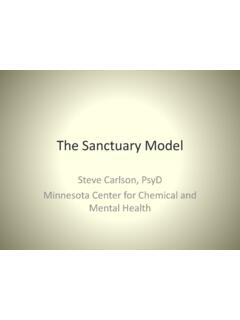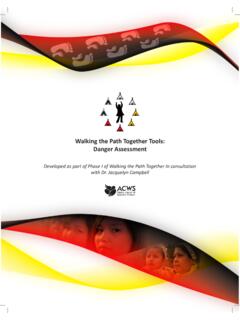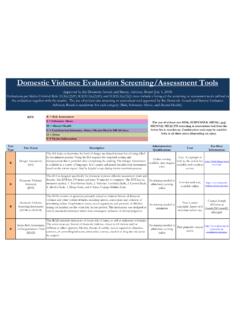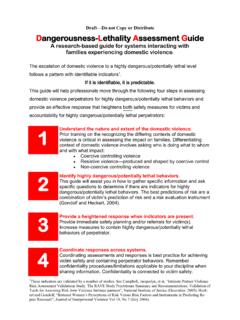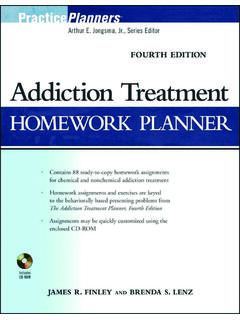Transcription of Assessment Using the ASAM Dimensions
1 Using the ASAM Framework for Co-Occurring DisordersTanya Freedland, MPS, LADCC linical Trainer & Research AssociateASAM BasicsWhat is ASAM?Fees, T. (2013). The ASAM criteria: Treatment criteria for addictive, substance-related and co-occurring BasicsWhat is ASAM? Guide for providers to develop care plans Make objective decisions about placement along the continuum of careFees, T. (2013). The ASAM criteria: Treatment criteria for addictive, substance-related and co-occurring BasicsWhat is ASAM?Fees, T. (2013). The ASAM criteria: Treatment criteria for addictive, substance-related and co-occurring BasicsGuiding Principles of ASAM Criteria Moving from one dimensional to multidimensional Assessment Moving from program driven treatment to clinically driven and outcomes driven treatment Moving from fixed to variable length of treatmentFees, T. (2013). The ASAM criteria: Treatment criteria for addictive, substance-related and co-occurring BasicsGuiding Principles of ASAM Criteria Moving from limited number of levels of care to broad and flexible continuum of care Identifying specific needs of adolescents Clarifying goals of treatmentFees, T.
2 (2013). The ASAM criteria: Treatment criteria for addictive, substance-related and co-occurring BasicsGuiding Principles of ASAM Criteria Moving away from treatment failure as a prerequisite for admission Moving toward multidisciplinary team-based care Clarifying physician role in care Focusing on treatment outcomesFees, T. (2013). The ASAM criteria: Treatment criteria for addictive, substance-related and co-occurring BasicsElements of a Biopsychosocial Assessment Description of present episode Family History Developmental History Substance use and addictive behavior history Social and legal history Psychiatric History Medical historyFees, T. (2013). The ASAM criteria: Treatment criteria for addictive, substance-related and co-occurring BasicsElements of a Biopsychosocial Assessment Spiritual history Review of symptoms Mental status examination Physical examination Formulation and diagnosis Survey of assets, vulnerabilities, and support Treatment recommendationsFees, T.
3 (2013). The ASAM criteria: Treatment criteria for addictive, substance-related and co-occurring RatingWhat are risk ratings and why do we care?Dimension 1 Acute Intoxication and WithdrawalPotentialDimensional RatingDimension 1 - Assessment Considerations Are there risks with client s current level of intoxication or withdrawal? If so, what are they? Is there a history of severe withdrawal symptoms?Fees, T. (2013). The ASAM criteria: Treatment criteria for addictive, substance-related and co-occurring RatingDimension 1 - Assessment Considerations Are services needed to address current intoxication or withdrawal? Is ambulatory withdrawal safe to consider?Fees, T. (2013). The ASAM criteria: Treatment criteria for addictive, substance-related and co-occurring RatingWithdrawal Warning Signs -Alcohol and Benzos 2 hours to 4 days after stopping drinking Headache, fast heart rate, or insomnia Nausea, vomiting, or lack of appetite Tremors, shakiness, restlessness Anxiety, agitation, or irritability Hallucinations or disorientation Seizures or insomniaDimensional RatingSarah Self referred for care due to anxiety and depression Used meth and cannabis heavily over the past 2 years Not Using meth now, last use was a week prior to Assessment Using cannabis regularly, in the morning for anxiety and at night to go to sleep Risk rating 0 Dimensional RatingRon Referred from corrections after being arrested under the influence for assault Drinks heavily, more than 5 standard drinks per day Reports that he hasn t had a drink for 24 hours Appears sweaty, shaky.
4 And is having a difficult time engaging in conversations Risk rating 3 Dimension 2 Biomedical Conditions and ConcernsDimensional RatingDimension 2 - Assessment Considerations Are there current physical illnesses that need care? Are chronic illnesses or conditions in need of stabilization?Fees, T. (2013). The ASAM criteria: Treatment criteria for addictive, substance-related and co-occurring RatingDimension 2 - Assessment Considerations Does the client have a communicable disease that impacts others? Is the client pregnant? (especially important for opioid use disorders)Fees, T. (2013). The ASAM criteria: Treatment criteria for addictive, substance-related and co-occurring RatingSarah Has lower back pain since her 20 s (39 years old currently) Has been prescribed pain medications, but doesn t believe that they help Reports history of fibromyalgia that flares up and causes problems Has no regular primary care and is open to it Risk rating 1 Dimensional RatingRon Denies any medical concerns Smokes 1-2 packs of cigarettes per day Does not like doctors and avoids going at all costs Has a black eye and a finger that appears to be broken Reports that he did not receive medical care while in custody Risk rating 2 Dimension 3 Emotional Behavioral or Cognitive Conditions and ComplicationsDimensional RatingDimension 3 - Assessment Considerations Are there current psychological, behavioral, emotional, or cognitive issues that need to be addressed?
5 Are there chronic conditions that need stabilization? ( bipolar disorder or chronic anxiety)Fees, T. (2013). The ASAM criteria: Treatment criteria for addictive, substance-related and co-occurring RatingDimension 3 - Assessment Considerations Do symptoms appear to connect to the addiction or are they separate? Most people with Substance Use Disorders have problems in this dimension related to their disorder and it is difficult to tell if these are separate until there is a period of , T. (2013). The ASAM criteria: Treatment criteria for addictive, substance-related and co-occurring RatingDimension 3 - Assessment Considerations Are any of the signs or symptoms severe enough to need mental health treatment? Can the client cope with emotional, behavioral, or cognitive conditions? Is the client able to manage the activities of daily life?Fees, T. (2013). The ASAM criteria: Treatment criteria for addictive, substance-related and co-occurring RatingDimension 3 -Risk Domains dangerousness and lethality Likelihood of self harm or harm to others History of impulsivity Immediacy of riskFees, T.
6 (2013). The ASAM criteria: Treatment criteria for addictive, substance-related and co-occurring RatingDimension 3 -Risk Domains Interference with Recovery Efforts Mental Illnesses interference with substance use disorder recovery Substance Use Disorders interference with mental health recoveryFees, T. (2013). The ASAM criteria: Treatment criteria for addictive, substance-related and co-occurring RatingDimension 3 -Risk Domains Social Functioning How much does a person s substance use interfere with relationships Does the use prevent a person from fulfilling roles and responsibilities?Fees, T. (2013). The ASAM criteria: Treatment criteria for addictive, substance-related and co-occurring RatingDimension 3 -Risk Domains Ability for Self-Care Impairment in ability to bathe or wear appropriate clothing Does the substance use affect the ability to obtain food and shelter?Fees, T. (2013).
7 The ASAM criteria: Treatment criteria for addictive, substance-related and co-occurring RatingDimension 3 -Risk Domains Course of Illness History of chronicity of illness Acute signs and symptoms Instability leads to higher risk ratingsFees, T. (2013). The ASAM criteria: Treatment criteria for addictive, substance-related and co-occurring RatingSarah Youngest of 4 children mother and father divorced when she was 10 Reported reading difficulties but was able to overcome them Interest in school declined during high school as friends became more important Did not go to college and has been employed in retail Dimensional RatingSarah Reports feeling depressed most of the day, every day and is having difficulty getting to work She has had episodes like this since middle school Wakes up anxious and on edge She reports she is very tired but cannot sleep well Passing suicidal thoughts but reports she would never act on them Risk rating 2 Dimensional RatingSarah Began Using cannabis in at age 14 and has been smoking consistently since then, except during pregnancy Drinking began at age 15, but does not drink more than 3 times per month.
8 2 drinks per episode Meth use started in mid 20 s she indicates she often uses when she feels really bad and it doesn t go away Risk rating 2 Dimensional RatingRon Oldest child of 6, parents remain married but were not affectionate with each other No history of mental illness in the family but reports that everyone drinks Had difficulty getting along with others in school and struggled with learningDimensional RatingRon No history of mental health care Reports no symptoms of note but indicates his mood is low and has been that way for a long time Does not have suicidal thoughts, but sometimes thinks about killing his boss when he is angry about a work assignment States he needs his job and would never act on itDimensional RatingRon Regular drinking started when he was in high school and partied on the weekends Went to community college for welding and began drinking daily 2-4 beers Started drinking whiskey in early 30 s, it took the edge off better and helped him deal with his wife Has been drinking 2 glasses of whiskey and a 6-pack of beer per day since divorce 3 years ago Risk rating 1 Dimension 4 Readiness to ChangeDimensional RatingDimension 4 - Assessment Considerations How aware is the client of the relationship between their substance use or behaviors of pathological reward seeking and the consequences of those behaviors?
9 What is their readiness to change in other areas? Mental Health, Employment, Physical Health, , T. (2013). The ASAM criteria: Treatment criteria for addictive, substance-related and co-occurring RatingDimension 4 - Assessment Considerations How ready, willing, or able is the client to change? How much control does the client feel they have over the services they receive?Fees, T. (2013). The ASAM criteria: Treatment criteria for addictive, substance-related and co-occurring RatingSarah Reports she wants to get better and needs help Skeptical of therapy but thinks that treatment can help her stop Using meth and cannabis Usually drops out of therapy after one session Risk rating 1 SUD, 2 MIDimensional RatingRon Is willing to do the Assessment , just to get it over with Doesn t believe in shrinks Wants to get on with his life If told to go to treatment, would fight it in court Risk rating 3 SUD, 3 MIDimension 5 Relapse Continued Use or Continued Problem PotentialDimensional RatingDimension 5 -What is Relapse?
10 The return to active addiction after a period of recoveryThe return of active illness or problem behavior after a period of recoveryFees, T. (2013). The ASAM criteria: Treatment criteria for addictive, substance-related and co-occurring RatingDimension 5 - Assessment Considerations Is the client in immediate danger of severe mental health issues or continued substance use? Does the client have any understanding of coping skills to manage relapse continued use or continued problems?Fees, T. (2013). The ASAM criteria: Treatment criteria for addictive, substance-related and co-occurring RatingDimension 5 - Assessment Considerations Have medications helped with recovery in the past? What are the client s skills for coping with cravings, withdrawal, or impulses? How well can the client cope with negative emotions, peer pressure, stress and thoughts of substance use?Fees, T. (2013). The ASAM criteria: Treatment criteria for addictive, substance-related and co-occurring RatingDimension 5 - Assessment Considerations How severe are the problems and distress experienced by the client if they are not engaged in treatment and continue to use substances, engage in addictive behaviors, or have mental health problems?
